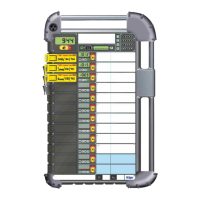8 Dräger PSS
®
Merlin
®
Description and Intended Use
3 Description and Intended Use
3.1 Electronic monitoring system
An electronic monitoring system comprises a monitoring device paired with, or incorporating, a communication device. The
monitoring device provides visual and audible information about the status of a breathing apparatus. The communication device
transmits information from the monitoring device to compatible telemetry systems and other compatible devices, such as head-
up displays.
The following electronic monitoring systems are compatible with the PSS® Merlin® Entry Control Board.
Bodyguard
®
II plus Portable Radio Unit.
Bodyguard
®
7000 with PSS
®
Merlin
®
Modem.
Connect ECU.
Refer to the following for a full description:
Bodyguard
®
II – refer to Appendix A – on Page 29.
Bodyguard
®
7000 – refer to Appendix B – on Page 32.
Connect ECU - refer to PSS AirBoss Connect instructions for use.
3.2 The Entry Control Board
The Dräger PSS
®
Merlin
®
Entry Control Board (ECB) is a battery-powered unit incorporating an integral digital radio transmitter
and receiver with associated antenna. The ECB has twelve channel slots each able to accept the encoded tally of an individual
electronic monitoring system. Inserting the tally activates the transmission link monitoring capability between the ECB, and the
electronic monitoring system. The last two channels (11 and 12) are colour-coded blue and are normally allocated as standby
channels for use by an emergency team.
Entry Control Boards are individually programmed with an equipment owner identification number (Brigade ID) and a board
identification number.
The data transmission link (logon) between the Entry Control Board and each breathing apparatus electronic monitoring system
is activated following the insertion of a tally (an electronic key with an embedded encoded transponder) into any of the available
channels of the board. The tally is encoded with the same codes as the corresponding electronic monitoring system.
The ECB identifies the associated electronic monitoring system and an on-line radio icon illuminates (green) continuously,
confirming a successful radio communication link. An individual channel screen defaults to show the actual Time of Whistle
information.
At an incident, the use of the Entry Control Board (ECB) is normally the responsibility of an Entry Control Officer (ECO). The ECO
must ensure that agreed control procedures are in place to manage, monitor and safeguard the wearer of the breathing
apparatus.
To support any possible requirement for incident analysis information, the ECB stores and maintains an event log (datalog) that
can be downloaded to a computer. Contact Dräger for full details of associated software.
For positive and secure support of the ECB at and during an incident a support bracket is available for fitment to a tripod unit.
Contact Dräger for details.
3.3 Receiving Information
The on-line radio icon illuminates (green) at each channel of the ECB indicating satisfactory radio contact with the associated
electronic monitoring system.
The Time of Whistle (TOW) default shown on the individual channel screens is calculated automatically by the ECB by adding
the Time to Whistle (TTW) value transmitted of the electronic monitoring system, to the actual time shown on the real time clock
of the ECB.
The following additional ongoing data is communicated to the ECB every 20 seconds from each logged-on electronic monitoring
system:
Time to Whistle.
Cylinder pressure.

